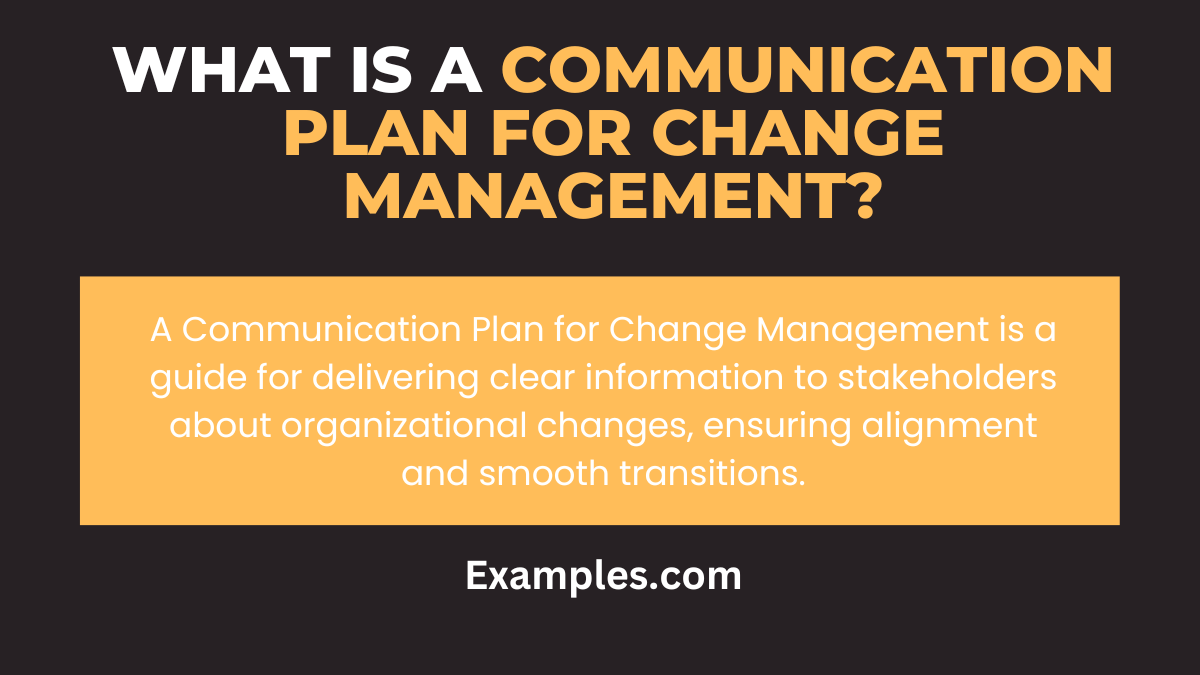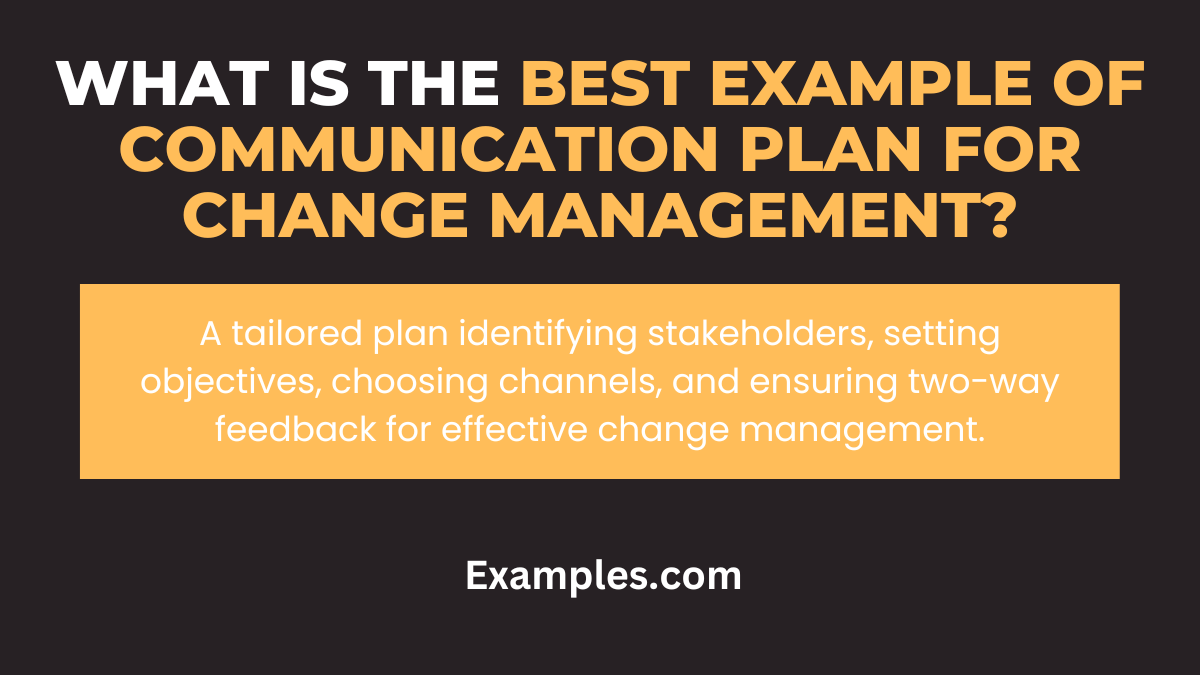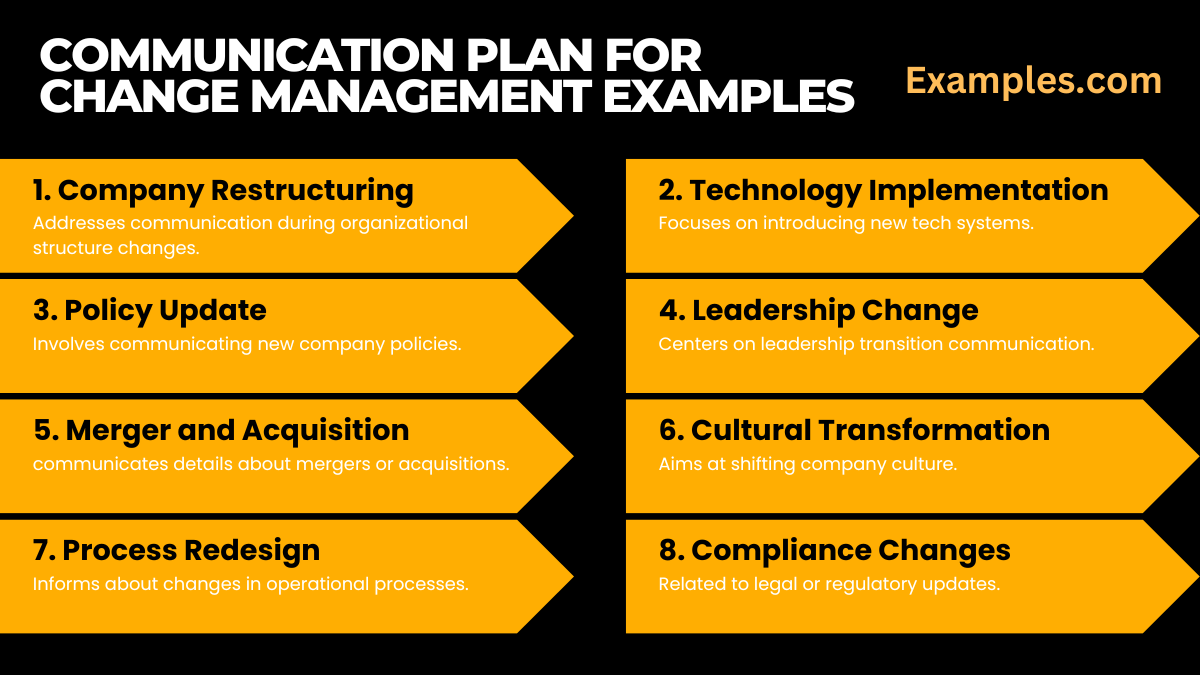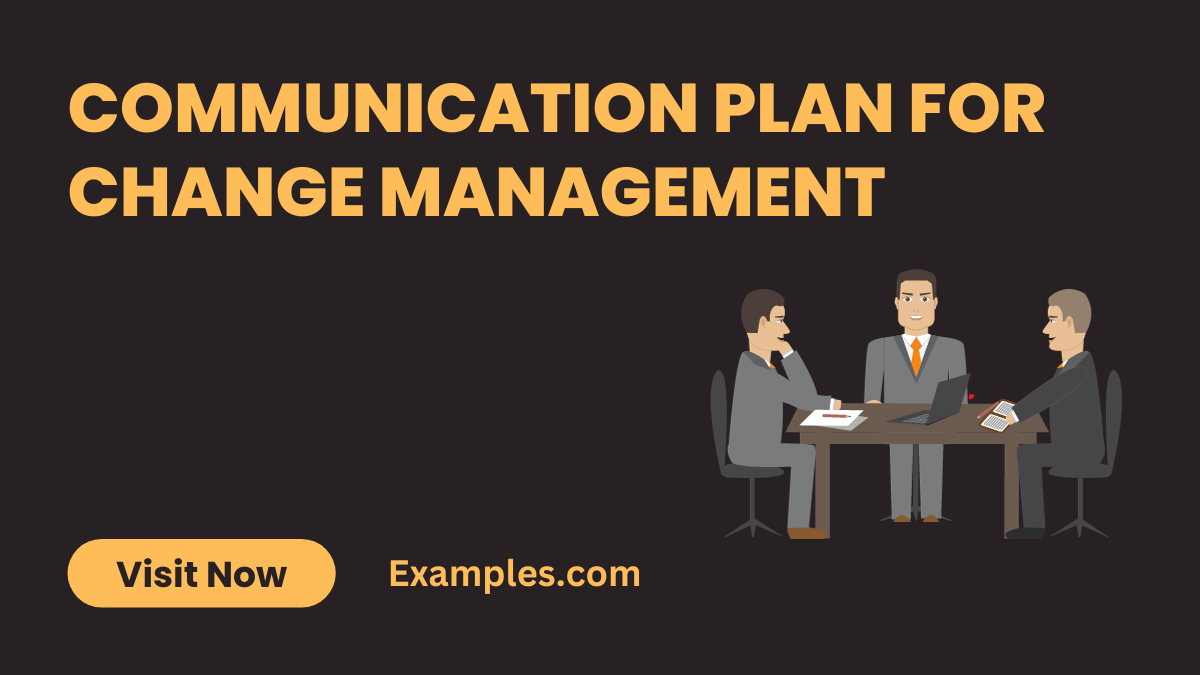9+ Communication Plan for Change Management Examples
Explore the essentials of a Communication Plan for Change Management in our comprehensive guide, enriched with practical examples. Delve into the nuances of crafting effective strategies, encompassing diverse Organizational Communication Techniques and Stakeholder Engagement Methods. This guide illuminates the path for Internal Communication Improvement and deploying Change Implementation Plans with real-world Communication Examples. It’s an invaluable resource for anyone looking to master Effective Messaging in Change and Resistance Management Communication, key aspects of successful organizational transformation.
Download List of Communication Plan for Change Management
What is a Communication Plan for Change Management?

A Communication Plan for Change Management is a strategic blueprint outlining how to convey information about organizational changes. It details who will receive what information, when and how they will receive it, and who will deliver it. This plan ensures that all stakeholders, from employees to leadership, are on the same page during times of transition. It’s about managing expectations, reducing resistance, and promoting a smooth adaptation to new ways of working. Essentially, it’s a road map for ensuring clear, consistent, and effective communication throughout the change process.
What is the Best Example of Communication Plan for Change Management?

The best example of a Communication Plan for Change Management is one that is tailored to a company’s specific needs but generally includes several key elements. It begins with a thorough analysis of the change impact and stakeholder identification. The plan outlines clear objectives, like ensuring understanding and minimizing resistance. It then details the communication channels to be used, such as emails, meetings, and internal platforms. Importantly, it sets a timeline for when communications will occur and assigns responsibilities for messaging. Additionally, the plan includes feedback mechanisms for stakeholders to express concerns or ask questions, ensuring a two-way communication flow. This holistic approach ensures that every aspect of the change is communicated effectively, reducing uncertainties and fostering a positive reception of the change.
10 Communication Plan for Change Management Examples

Communication Plans for Change Management are crucial in guiding organizations through transitions effectively. These plans address challenges like miscommunication, resistance, and confusion, fostering a smooth adaptation to change. By integrating strategies such as stakeholder engagement, clear messaging, and feedback loops, they ensure everyone is aligned with the new direction. The plans cater to various scenarios, from company restructures to technology implementation, ensuring comprehensive coverage of all change aspects.
- Company Restructuring: Addresses communication during organizational structure changes.
Fix: Regular updates and open forums for employee feedback. - Technology Implementation: Focuses on introducing new tech systems.
Fix: Training sessions and clear instructions on changes. - Policy Update: Involves communicating new company policies.
Fix: Detailed explanations and Q&A sessions. - Leadership Change: Centers on leadership transition communication.
Fix: Introduce new leaders through meetings and profiles. - Merger and Acquisition: Communicates details about mergers or acquisitions.
Fix: Transparent information about changes and impacts. - Cultural Transformation: Aims at shifting company culture.
Fix: Consistent messaging and involvement of cultural ambassadors. - Process Redesign: Informs about changes in operational processes.
Fix: Workflow diagrams and hands-on training. - Compliance Changes: Related to legal or regulatory updates.
Fix: Detailed guidelines and compliance training sessions. - Global Expansion: Communicates around expanding into new markets.
Fix: Multilingual communication and cultural awareness training. - Crisis Management: Deals with communication during crises.
Fix: Immediate, clear, and factual updates.
What are the Objectives of a Change Management Communication Plan?
The objectives of a Change Management Communication Plan are to ensure that all parties affected by organizational changes are fully informed and prepared. This includes:
- Promoting Understanding: Clearly explaining the reasons for change, expected outcomes, and how it will affect various stakeholders.
- Fostering Buy-in and Support: Encouraging stakeholders to embrace the change by highlighting its benefits and addressing concerns.
- Minimizing Resistance: Identifying potential areas of push back and proactively addressing them through targeted communication.
- Ensuring Consistent Messaging: Maintaining message alignment across all channels and stakeholders to avoid confusion.
- Facilitating Smooth Transition: Providing timely updates and guidance to ensure everyone is aligned with the new changes.
- Encouraging Two-way Communication: Creating channels for feedback, allowing stakeholders to express concerns and ask questions.
Communication Plan for Change Management Sample
- Stakeholder Analysis: Identifying who will be impacted by the change and their specific needs.
- Communication Goals: Defining what the communication aims to achieve, like awareness, understanding, or action.
- Key Messages: Crafting clear and concise messages tailored to different stakeholder groups.
- Channels and Tools: Deciding on the most effective ways to deliver these messages, such as email, intranet, meetings, or social media.
- Timeline: Laying out when each communication will be sent, aligning with key milestones of the change process.
- Responsibilities: Assigning team members specific communication tasks and roles.
- Feedback and Measurement: Setting up methods to gather stakeholder feedback and measure the effectiveness of communication efforts.
- Adjustment Mechanism: Planning for ongoing review and adaptation of the communication strategy based on feedback and changing needs.
What are the Steps in Communication Plan for Change Management?
- Stakeholder Analysis: Identify who will be affected by the change and understand their needs and concerns.
- Define Objectives: Set clear goals for what the communication plan aims to achieve.
- Develop Key Messages: Craft messages tailored to different stakeholder groups to address their specific concerns and needs.
- Choose Communication Channels: Select appropriate channels to reach different stakeholders effectively.
- Implement and Review: Execute the communication plan and continuously review its effectiveness, making adjustments as needed.
What are the Elements of a Communication Plan for Change Management?
- Stakeholder Identification: Listing all individuals or groups affected by the change.
- Communication Goals: Clearly defined objectives of what the plan aims to achieve.
- Key Messages: Tailored messages addressing the specific concerns and needs of each stakeholder group.
- Communication Channels: Various mediums through which messages will be delivered.
- Timeline: Schedule for when communications will be released.
- Roles and Responsibilities: Assigning team members specific tasks related to the communication effort.
- Feedback Mechanism: Channels for stakeholders to provide their feedback and concerns.
Role of Communication in Change Management
In Change Management, communication plays a vital role in ensuring stakeholders are aware, engaged, and supportive of the change. Effective communication helps to manage expectations, reduce resistance, and build trust, thereby facilitating a smoother transition. It acts as a bridge between the organization and its stakeholders, keeping everyone informed and aligned with the change objectives.
Skills Needed to Lead a Change Management Plan
Effective leadership in change management requires strong communication Skills, empathy, strategic thinking, adaptability, and problem-solving skills to guide successful transitions.
The Importance of Internal Communication During Change Management
Effective internal communication channels is paramount in change management as it ensures transparency, builds trust, and maintains employee engagement. It aligns staff with new objectives, fosters a culture of collaboration, and mitigates resistance by keeping everyone informed and involved. This communication nature a supportive environment, essential for the successful adaptation to changes, whether they are strategic, structural, or technological.
Define Your Change Management Goals
Defining Change Management Goals involves setting clear, measurable objectives focused on smooth transition, effective engagement, minimizing resistance, and aligning with organizational strategy.
The guide on Communication Plans for Change Management is an extensive resource that delves deep into the strategies and techniques necessary for effective change management communication. It emphasizes the importance of aligning stakeholders with the organizational vision during transitions, mitigating resistance, and ensuring a seamless adaptation to new processes or structures. The guide highlights the significance of creating a tailored communication plan that addresses the specific needs of a company and its stakeholders, making it an indispensable tool for any organization undergoing change.
To enhance your understanding of effective communication strategies in change management, Prosci offers a comprehensive checklist that can be utilized as a reference. This checklist provides valuable insights into the key components of a successful communication plan. For more details, visit Prosci’s Communications Checklist for Change Management.
Additionally, The Grossman Group offers insightful perspectives on change management communication. Their blog discusses various aspects of communication strategy and its critical role in facilitating organizational change. To explore these insights, visit The Grossman Group – Change Management Communication??.



